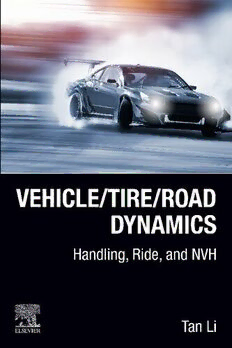
Vehicle/Tire/Road Dynamics: Handling, Ride, and NVH PDF
Preview Vehicle/Tire/Road Dynamics: Handling, Ride, and NVH
Vehicle/Tire/Road Dynamics This page intentionally left blank Vehicle/Tire/Road Dynamics Handling, Ride, and NVH Tan Li Maxxis Technology Center, Maxxis International—USA, Suwanee, GA, United States Elsevier Radarweg29,POBox211,1000AEAmsterdam,Netherlands TheBoulevard,LangfordLane,Kidlington,OxfordOX51GB,UnitedKingdom 50HampshireStreet,5thFloor,Cambridge,MA02139,UnitedStates Copyright©2023ElsevierInc.Allrightsreserved. Nopartofthispublicationmaybereproducedortransmittedinanyformorbyanymeans,electronic ormechanical,includingphotocopying,recording,oranyinformationstorageandretrievalsystem,without permissioninwritingfromthepublisher.Detailsonhowtoseekpermission,furtherinformationabout thePublisher’spermissionspoliciesandourarrangementswithorganizationssuchastheCopyright ClearanceCenterandtheCopyrightLicensingAgency,canbefoundatourwebsite:www.elsevier.com/ permissions. ThisbookandtheindividualcontributionscontainedinitareprotectedundercopyrightbythePublisher (otherthanasmaybenotedherein). Notices Knowledgeandbestpracticeinthisfieldareconstantlychanging.Asnewresearchandexperiencebroaden ourunderstanding,changesinresearchmethods,professionalpractices,ormedicaltreatmentmaybecome necessary. Practitionersandresearchersmustalwaysrelyontheirownexperienceandknowledgeinevaluating andusinganyinformation,methods,compounds,orexperimentsdescribedherein.Inusingsuch informationormethodstheyshouldbemindfuloftheirownsafetyandthesafetyofothers,including partiesforwhomtheyhaveaprofessionalresponsibility. Tothefullestextentofthelaw,neitherthePublishernortheauthors,contributors,oreditors,assume anyliabilityforanyinjuryand/ordamagetopersonsorpropertyasamatterofproductsliability,negligence orotherwise,orfromanyuseoroperationofanymethods,products,instructions,orideascontained inthematerialherein. ISBN:978-0-323-90176-5 ForinformationonallElsevierpublications visitourwebsiteathttps://www.elsevier.com/books-and-journals Publisher:MatthewDeans AcquisitionsEditor:ChiaraGiglio EditorialProjectManager:SaraGreco ProductionProjectManager:KameshR CoverDesigner:MilesHitchen TypesetbySTRAIVE,India Contents 1 Introduction 1 1.1 Background 1 1.2 Literature 2 1.3 Organization 3 References 12 2 Definitions and fundamentals 15 2.1 Multibody dynamics 15 2.2 Vibrations 19 2.3 Control 25 2.4 Structure-borne acoustics 44 2.5 Airborne acoustics 63 2.6 Acoustic resonance 84 References 93 3 Tire and vehicle handlingdynamics 95 3.1 Tire handling theory 95 3.2 Vehicle handling theory 138 3.3 Handling test, measurement, and evaluations 174 3.4 Handling simulation approaches 220 References 270 4 Tire and vehicle ride dynamics 275 4.1 Vehicle ride theory 275 4.2 Tire ride theory 295 4.3 Ride test,measurement, and evaluations 310 4.4 Ride simulation approaches 347 References 356 5 Tire and vehicle NVH 359 5.1 Structure-borne acoustics 360 5.2 Airborne acoustics 372 5.3 Sound quality theory 380 5.4 NVH test, measurement, and evaluations 391 5.5 NVH simulation approaches 434 References 454 vi Contents 6 Dependence betweenhandling, ride, and NVH 459 6.1 Fundamental tire material properties 459 6.2 Stress anddeformation distributionintire contact patch 485 6.3 Conflicts between safety and comfort 512 6.4 Optimization with active suspension control 518 6.5 Braking and corneringnoise 525 References 536 7 Road effect on handling,ride, and NVH 539 7.1 Surface texturecharacterization 539 7.2 Influenceof surface texture ontire grip 539 7.3 Influenceof the road profileon vehicle comfort 559 7.4 Influenceof pavement parameters on NVH 560 7.5 Road dynamics 581 References 584 8 Intelligenttireand autonomous electric vehicle 589 8.1 Vehicle/tire state and parameter estimation 589 8.2 Dynamicscontrol for electric vehicles 600 8.3 Smart tire 603 References 614 Appendix1:Example specifications of differenttypes of vehicles 617 Appendix2:Literature review for tire modal analysis 631 Index 647 1 Introduction 1.1 Background Kinematics is a subfield of classical mechanics that describes the motion of points, bodies (objects), and systems of bodies (groups of objects) without considering the forcesthatcausethemtomove.Dynamicsisthebranchofclassicalmechanicscon- cernedwiththestudyofforcesandtheireffectsonmotion.Obviously,thetopicinthis book considers underlying forces and computes motion from initial conditions and physics,so vehicle dynamics is the correct term. DynamicsisgovernedbyequationsofmotionorNewton’sSecondLawofMotion. Inthisbook,dynamicsisanalternativetermtomotion.Inphysics,motionisthephe- nomenoninwhichanobjectchangesitspositionovertime.Motionismathematically described intermsofdisplacement, velocity, acceleration, and time.Themotion ofa bodyisobservedbyattachinga frame ofreferencetoanobserverand measuring the changeinpositionofthebodyrelativetothatframe.Inthisbook,motioniscategorized into movement and vibration. In philosophy, everything in the Universe moves and vibrates. Movement is defined as a continual change of physical location relative to a reference frame. Generally, the removal of applied external forces will not lead to the body returning to its original location. For vehicle handling analysis focusing on planar/horizontalmotion,thevehiclesystemisusuallytreatedasasinglebodyhaving onlyonemovementwithoutconsideringthewheelmovements.Vibrationisdefinedas theoscillationofamechanicalorstructuralsystemarounditspointofequilibrium.After theremovalofexternalexcitations,asystemwilleventuallyreturntoastateofequi- libriumaslongasdampingexists.Forvehiclerideanalysisfocusingonverticalmotion, thevibrationsofbodyandwheelsusuallymodeledaslumpedmasses(rigidbodies)are bothconsidered. Modal analysis techniquesare typicallyapplied tolinear systems to study their modal properties as described by system natural frequency, mode shape, anddampingratio.Inthisbook,oscillationisanalternativetermtovibration. NVHstandsfornoise,vibration,andharshness.Noiseisusuallyconsideredasan unwantedsound.However,“wanted”or“unwanted”dependsuponthelistenerandthe circumstances.Forexample,rockmusiccanbepleasurablesoundtoonepersonbutan annoyingnoisetoanother.Inthisbook,soundisanalternativetermtonoise.Vibration can generate noise by sound radiation and noise can also cause vibration by fluid- structureinteraction.Harshnessisthesubjectiveimpressionsofthenoise.Inhandling andrideanalysis,thevehicleisconsideredasasinglebodyoranintegratedsystemof multiplebodiesconnectedelasticallywitheachother,thatis,eachbodyisonelumped masswheremotionsofitspartsareinphase.However,inNVHanalysis,thebodyhas tobedistributedmasswheremotionsofitspartsarenotinphase,allowingacoustic waves to propagate inside the structure or radiate into the air. The sound field and vibration map inthe vehicle cabin are highlynonuniform.Thesoundpressure level atdriver’searclosertothewindowcanbe3dBhigherthanthatattheotherear;the Vehicle/Tire/RoadDynamics.https://doi.org/10.1016/B978-0-323-90176-5.00003-6 Copyright©2023ElsevierInc.Allrightsreserved. 2 Vehicle/Tire/RoadDynamics soundpressurelevelattherearseatcanalsobe3dBhigherthanatthefrontseat.The vibrationlevelscanalsobedifferentonthefloor,seat,andsteeringwheel,whichis usuallynotinthescopeofridevibrationsfocusedonsmoothnessatthevehiclecenter of gravity. It is also implied that NVH is a highly subjective performance, which is why sound quality becomes more and more important for vehicle product quality. Similarly, handling quality and ride quality in terms of subjective evaluations have drawnhigherattentionrecently. Insummary,thereisaspectrumofvehicleperformanceareas:handlingforlowfre- quency(<10Hz),rideformiddlefrequency(10–100Hz),andNVHforhighfrequency (>100Hz).Conventionally,“vehicledynamics”onlyimpliedhandlingthatismostcrit- icalrelatingtosafety,lateritmergedwithridebecausecomfortbecameimportant,now NVHhasdrawnhigherattentionforproductquality.Allofthethreeareasareactually dynamics,butwearenotusedtocallingNVHdynamicsyet.Allthreeareascanbeana- lyzed in frequency and time domain, though handling is usually analyzed in time domainwhileNVHinfrequencydomain.Inthisbook,bothfrequencydomainanalysis andtimedomainanalysiswillbepresentedforallthreeareas.Asummarycomparison betweenvehiclehandling,ride,andNVHisshowninTable1.1. Generally,therearefivemajornoisesourcesforavehiclewithinternalcombustion engine (ICE): powertrain, intake system, exhaust system, aerodynamic turbulence (wind),andtire-roadinteraction.Foranelectricvehicle(EV),thepowertrainnoisefrom electricmotorismuchlowerthanICE,andtheintake/exhaustnoiseisremoved.This bookmainlyfocusesontire-road-inducedNVH,whichisdominantforregularvehicle speeds.Traditionally,vehicleperformanceislimitedbytheICE,astheenginedeter- minesthevehicletractioncapabilityandgeneratesmostoftheinteriornoiseunderreg- ularconditions.However,electricmotorwithhightorqueandlownoisecaneliminate thosedisadvantagesofICE.Hence,theperformanceofEVswillbelargelydependent ontiresprovidingsufficientgripandminimizingroadnoise.Vehicleelectrificationcan also provide more spacious passenger compartment due to compact powertrain/ drivetrainsystemandlowerheightofcenterofgravityduetothebatteryarrangement underthevehiclebody,whichimprovesridecomfortandrollstability.Theadvanced suspensiontechnologyalsoputstireinamoreimportantroleinimprovingvehiclecom- fort. Therefore, tire, as a component of vehicle system, will be critical for the major vehicle performances including handling, ride, and NVH. The tire contact patch is theonlyinteractionbetweenavehicleandtheroad;theforcesgeneratedinthispatch dictatethemovementandvibrationofthevehicle.Fortheautonomousvehicle,dueto littleornocontrolofthevehicle,occupantsmayhavedifferentperspectivesregarding handling(lowerrequirementsforsteeringfeelbuthigherrequirementsforsafety/stabil- ity)andhigherstandardsforridecomfortandNVH. 1.2 Literature Acomprehensivesearchforpublishedbooksonvehiclehandling/ride/NVHhasbeen performed,aslistedinTable1.2.Thesearegoodreferencesforreaderstodelveinto specificareasofinterest.However,itcanbeseenthatthereisaneedtoputtogethera book coveringall the areas. Introduction 3 Table1.1 Comparisonsbetweenvehiclehandling,ride,andNVH. Handling Ride NVH Vehicle Onelumpedmass Multiple Multipledistributed/ model lumped/discrete continuousmasses masses(rigid (flexiblecomponent) body) Tiremodel Spring Springorfinite Finiteelement element Driver Steeringwheel,throttle/ Mostlycruise Mostlycruise/coast input brake,gear Excitation Tire-roadfriction Road Tire-pavement irregularity roughness impact Motion Movement Movementand Vibration category vibration Vibration NA Freeresponse Forcedresponse response Typical Time Timeand Frequency(above analysis frequency 100Hz) domain (below100Hz) Time Maxperformance Impactpeakand Soundquality: domain damping fluctuation, scope roughness Frequency Stabilitycontrol Modal Spectraldistribution domain oscillation andweighting scope State Steady-stateortransient Mostlytransient Mostlysteady-state Parameters Maxvehiclelongitudinal/ Roll/pitchangle, Soundpressure,rms ofinterest lateralacceleration/ max,andrmsof ofaccelerations velocity,yawrate,sideslip accelerations angle Implication Safety,stability,reliability Comfort,ease Pleasantness, quality,identity 1.3 Organization Tofilltheknowledgegapbetweendifferentareas,Chapter2presentedthebasicdef- initions and fundamentals relatedto vehicle handling, ride, andNVH. Inthegeneralizedvehicle/tiredynamics,thesteadystateortheshort-timetransient tireforcesdominatethevehiclehandlingbehavior(Chapter3);then,thefluctuationof thereactionforcesinfluencestheridequality(Chapter4);finally,thestabilizedoscil- lationofeachvehicle/tirecomponentrelatestoNVHperformance(Chapter5).How- ever, there are no clear-cut boundaries between vehicle handling, ride, and NVH.
